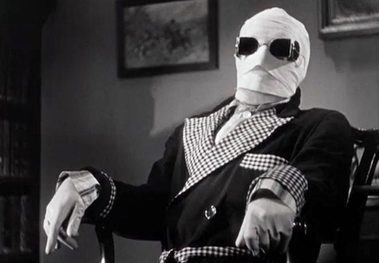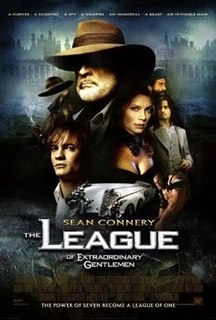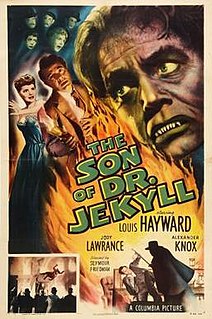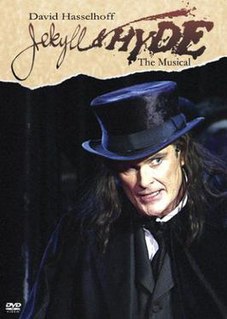Related Research Articles

Dr. Jekyll and Mr. Hyde is a 1931 American pre-Code horror film, directed by Rouben Mamoulian and starring Fredric March, who plays a possessed doctor who tests his new formula that can unleash people's inner demons. The film is an adaptation of The Strange Case of Dr Jekyll and Mr Hyde, the 1886 Robert Louis Stevenson tale of a man who takes a potion which turns him from a mild-mannered man of science into a homicidal maniac.

Dr. Henry Jekyll, nicknamed in some copies of the story as Harry Jekyll, and his alternative personality, Mr. Edward Hyde, is the central character of Robert Louis Stevenson's 1886 novella Strange Case of Dr Jekyll and Mr Hyde. In the story, he is a good friend of main protagonist Gabriel John Utterson. Jekyll is a kind and respected English doctor who has repressed evil urges inside of him. In an attempt to hide this, he develops a type of serum that he believes will effectively mask his dark side. Instead, Jekyll transforms into Edward Hyde, the physical and mental manifestation of his evil personality. This process happens more regularly until Jekyll becomes unable to control when the transformations occur.
Products are the species formed from chemical reactions. During a chemical reaction reactants are transformed into products after passing through a high energy transition state. This process results in the consumption of the reactants. It can be a spontaneous reaction or mediated by catalysts which lower the energy of the transition state, and by solvents which provide the chemical environment necessary for the reaction to take place. When represented in chemical equations products are by convention drawn on the right-hand side, even in the case of reversible reactions. The properties of products such as their energies help determine several characteristics of a chemical reaction such as whether the reaction is exergonic or endergonic. Additionally the properties of a product can make it easier to extract and purify following a chemical reaction, especially if the product has a different state of matter than the reactants. Reactants are molecular materials used to create chemical reactions. The atoms aren't created or destroyed. The materials are reactive and reactants are rearranging during a chemical reaction. Here is an example of reactants: CH4 + O2. A non-example is CO2 + H2O or "energy".
Marc Delafontaine was a Swiss chemist and spectroscopist who was involved in discovering and investigating some of the rare earth elements.

Griffin, also known as the Invisible Man, is a fictional character who first appeared as the protagonist of H. G. Wells' 1897 science fiction novel The Invisible Man. In the original work, Griffin is a scientist whose research in optics and experiments into changing the human body's refractive index to that of air results in him becoming invisible. After becoming invisible, he wraps his head in bandages and dons a pair of goggles or glasses in order to enable others to see him. Unable to reverse the invisibility process, he descends into insanity and becomes a criminal.

Jekyll & Hyde is a 1990 musical loosely based on the 1886 novella Strange Case of Dr Jekyll and Mr Hyde by Robert Louis Stevenson. Originally conceived for the stage by Frank Wildhorn and Steve Cuden, it features music by Frank Wildhorn, a book by Leslie Bricusse and lyrics by all of them. After a world premiere run in Houston, Texas, the musical embarked on a national tour of the United States prior to its Broadway debut in 1997. Many international productions in various languages have since been staged including two subsequent North American tours, two tours in the United Kingdom, a concert version, a re-vamped US tour in 2012, a 2013 Broadway revival featuring Constantine Maroulis, and an Australian concert version in 2019.
Self-experimentation refers to the special case of single-subject research in which the experimenter conducts the experiment on themselves. Usually this means that a single person is the designer, operator, subject, analyst, and user or reporter of the experiment.

The League of Extraordinary Gentlemen, also promoted as LXG, is a 2003 dieselpunk superhero film loosely based on the first volume of the comic book series of the same name by Alan Moore and Kevin O'Neill. Distributed by 20th Century Fox, it was released on 11 July 2003 in the United States, and 17 October 2003 in the United Kingdom. It was directed by Stephen Norrington and starred Sean Connery, Naseeruddin Shah, Peta Wilson, Tony Curran, Stuart Townsend, Shane West, Jason Flemyng and Richard Roxburgh. It was the final live-action acting role for Connery before his retirement in 2006 and death in 2020.

Argon fluorohydride or argon hydrofluoride is an inorganic compound with the chemical formula HArF. It is a compound of the chemical element argon.

Dr. Jekyll and Mr. Hyde is a 1908 silent horror film starring Hobart Bosworth, and Betty Harte in her film debut. Directed by Otis Turner and produced by William N. Selig, this was the first film adaptation of Robert Louis Stevenson's 1886 novel Strange Case of Dr Jekyll and Mr Hyde. The screenplay was actually adapted by George F. Fish and Luella Forepaugh from their own 1897 four act stage play derived from the novel, causing a number of plot differences with the original source. Despite Stevenson's protests, this film became the model which influenced all the later film adaptations that were to come.

Dr. Jekyll and Mr. Hyde is a 1913 horror film based on Robert Louis Stevenson's 1886 gothic novella The Strange Case of Dr. Jekyll and Mr. Hyde. Directed by Herbert Brenon for producer Carl Laemmle's company IMP, the production stars King Baggot in the dual role of Jekyll and Hyde. The film was re-released in the United States in August 1927.

ChemSpider is a database of chemicals. ChemSpider is owned by the Royal Society of Chemistry.

The Son of Dr. Jekyll is a 1951 American horror film directed by Seymour Friedman and starring Louis Hayward, Jody Lawrance and Alexander Knox. The film is a continuation of Robert Louis Stevenson's original classic 1886 novella Strange Case of Dr. Jekyll and Mr. Hyde.
Marjorie Mikasen is an abstract, geometric, hard-edge acrylic painter working in Lincoln, Nebraska. She has a degree in studio arts from The University of Minnesota. She is co-author with Mark Griep of the nonfiction book Re'Action!' Chemistry in the Movies.

Strange Case of Dr Jekyll and Mr Hyde is an 1886 novella written by the Scottish author Robert Louis Stevenson. It is about a London lawyer who investigates strange occurrences between his old friend, Dr. Henry Jekyll and the misanthropic Mr. Hyde.

Jekyll & Hyde: Direct from Broadway is a 2001 television film of the Broadway production of the 1990 musical Jekyll & Hyde as captured live in performance on Broadway featuring the show's final Broadway cast. The show was captured at Broadway's Plymouth Theatre in New York City December 2000 utilizing multiple high definition cameras by Broadway Worldwide.

Daughter of Dr. Jekyll is a low-budget black-and-white 1957 American horror film produced by Jack Pollexfen, directed by Edgar G. Ulmer and released by Allied Artists. The film is a variation on the 1886 gothic novella Strange Case of Dr. Jekyll and Mr. Hyde by Robert Louis Stevenson. It stars Gloria Talbott, John Agar and Arthur Shields. In the film, Janet Smith learns that she is not only the daughter of the infamous Dr. Henry Jekyll, but is convinced by her guardian, Dr. Lomas, that she has inherited her father's transformative condition. Janet begins to believe that she turns into a monster after two local women are found horribly killed and nearly takes her own life because of it. However, all is not what it seems.
David Kelham Smith is a professor of chemistry at the University of York in England. His research focuses on nanochemistry and self-assembling nanomaterials. Smith is also well known for his education and public outreach activities, such as his YouTube channel dedicated to chemistry disparagement. Smith is openly gay and has been described as "one of the most visible out gay scientists."

Frances Mary Gore Micklethwait, was an English research chemist, among the first to study and seek an antidote to mustard gas during the First World War. She received an MBE for her top secret wartime work, which has since come to light.
Jeffrey I. Seeman is a historian of science, chemist, and Visiting Senior Research Scholar in the Department of Chemistry at the University of Richmond in Richmond, Virginia. He is the editor of 20+ volumes in the series Profiles, pathways and dreams : autobiographies of eminent chemists. In addition to writing extensively as both a scientist and historian, he has produced short films for historical and educational use.
References
- ↑ "Oxford University Press Site for ReAction! Chemistry in the Movies".
- ↑ ""Films for Chemists" 1 December 2009 Chemistry World".
- ↑ Morgan, Edward (2010). "Lights, camera..." Nature Chemistry. 2 (2): 71. doi: 10.1038/nchem.522 .
- ↑ ""Films for Chemists" 1 December 2009 Chemistry World".
- ↑ Morgan, Edward (2010). "Lights, camera..." Nature Chemistry. 2 (2): 71. doi: 10.1038/nchem.522 .
- ↑ ""On Chemistry, Movies, and Making Science Entertaining" 5 January 2010 ScriptPhD.com".